Research on Carbon Reduction Pathways: A Case Study of Kau Yi Chau Artificial Islands
Abstract
1. Introduction
2. Research Methodology
2.1. Model Framework
2.2. LEAP Model
- (1)
- Carbon Emission Calculation for the Building Sector
- (2)
- Carbon Emission Calculation for the Transportation Sector
- (3)
- Carbon Emission Calculation for Solid Waste
- (4)
- Carbon Sink Calculation
2.3. Data Sources
2.4. Scenario Design
- (1)
- Baseline Scenario (BAS)
- (2)
- Low-Demand Scenario (S1)
- (3)
- Regular Carbon Reduction Scenario (S2)
- (4)
- Enhanced Carbon Reduction Scenario (S3)
- (5)
- Deepened Carbon Reduction Scenario (S4)
3. Results
3.1. Analysis of Energy Demand
3.2. Analysis of Carbon Source
3.3. Analysis of Carbon Sink
3.4. Analysis of Emission Reduction Effects in Key Sectors
4. Discussion
4.1. Low-Carbon Development Pathways
- (1)
- Optimizing Energy Efficiency in Commercial Buildings.
- (2)
- Advancing Low-Carbon Transition in Transportation Systems.
- (3)
- Implementing Integrated Waste Management Solutions.
- (4)
- Developing Eco-Friendly Greening Systems.
- (5)
- Enhancing Local Renewable Supply and Marine Carbon Sinks
4.2. Policy and Cost Considerations
4.3. Contribution to the Field
4.4. Limitations and Future Research Directions
5. Conclusions
Author Contributions
Funding
Data Availability Statement
Acknowledgments
Conflicts of Interest
References
- Cheng, J.; Chen, M.; Tang, S. Shenzhen—A typical benchmark of Chinese rapid urbanization miracle. Cities 2023, 140, 104421. [Google Scholar] [CrossRef]
- Weber, C.; Puissant, A. Urbanization pressure and modeling of urban growth: Example of the Tunis Metropolitan Area. Remote Sens. Environ. 2003, 86, 341–352. [Google Scholar] [CrossRef]
- Zhou, Y.S.; Zheng, Z.H.; Wu, Z.F.; Guo, C.; Chen, Y.B. Construction and evaluation of ecological networks in highly urbanised regions: A case study of the Guangdong-Hong Kong-Macao greater Bay Area, China. Ecol. Indic. 2023, 152, 110336. [Google Scholar] [CrossRef]
- Hong Kong Special Administrative Region. Hong Kong Overview. Available online: https://www.gov.hk/tc/about/abouthk/facts.htm (accessed on 20 June 2024).
- Development Bureau Hong Kong Special Administrative Region. Strategic Positioning, Planning Objectives and Highlights. Available online: https://www.centralwaters.hk/en/strategic-positioning-planning-objectives-highlights/ (accessed on 17 June 2024).
- Feng, D.W.; Gao, X.Y.; Yang, Y.; Feng, S.R.; Yang, X.H.; Yan, J.Y. Pathways for carbon emission prediction and mitigation of sustainable industrial parks: A LEAP model application. Int. J. Green Energy 2024, 22, 1135–1150. [Google Scholar] [CrossRef]
- Song, T.; Zou, X.L.; Wang, N.; Zhang, D.Y.; Zhao, Y.X.; Wang, E. Prediction of China’s Carbon Peak Attainment Pathway from Both Production-Side and Consumption-Side Perspectives. Sustainability 2023, 15, 4844. [Google Scholar] [CrossRef]
- Ming, X.X.; Wang, Q.; Luo, K.; Zhang, L.J.; Fan, J.R. An integrated economic, energy, and environmental analysis to optimize evaluation of carbon reduction strategies at the regional level: A case study in Zhejiang, China. J. Environ. Manag. 2024, 351, 119742. [Google Scholar] [CrossRef]
- Miao, A.K.; Yuan, Y.; Wu, H.; Ma, X.; Shao, C.Y.; Xiang, S. Pathway for China’s provincial carbon emission peak: A case study of the Jiangsu Province. Energy 2024, 298, 131417. [Google Scholar] [CrossRef]
- Wang, J.J.; Li, Y.; Zhang, Y. Research on Carbon Emissions of Road Traffic in Chengdu City Based on a LEAP Model. Sustainability 2022, 14, 5625. [Google Scholar] [CrossRef]
- Liu, Y.Y.; Chen, S.; Jiang, K.J.; Kaghembega, W.S.H. The gaps and pathways to carbon neutrality for different type cities in China. Energy 2022, 244, 122596. [Google Scholar] [CrossRef]
- Yuan, Y.; Wang, F.F.; Sun, L.; Liu, W.C.; Du, C.L.; Wang, C.Y.; Yao, Y. Promote the decarbonization pathways of eco-industrial parks by considering their CO2 emissions structures and characters. J. Clean. Prod. 2024, 450, 141989. [Google Scholar] [CrossRef]
- Zhou, D.Q.; An, Y.F.; Zha, D.L.; Wu, F.; Wang, Q.W. Would an increasing block carbon tax be better? A comparative study within the Stackelberg Game framework. J. Environ. Manag. 2019, 235, 328–341. [Google Scholar] [CrossRef]
- Zhou, Y.X.; Fang, W.S.; Li, M.J.; Liu, W.L. Exploring the impacts of a low-carbon policy instrument: A case of carbon tax on transportation in China. Resour. Conserv. Recycl. 2018, 139, 307–314. [Google Scholar] [CrossRef]
- Zhang, Y.F.; Li, S.; Luo, T.Y.; Gao, J. The effect of emission trading policy on carbon emission reduction: Evidence from an integrated study of pilot regions in China. J. Clean. Prod. 2020, 265, 121843. [Google Scholar] [CrossRef]
- Hao, J.H.; Ye, X.L.; Yu, C.F.; Liu, J.Y.; Ruan, Y.M.; Zhang, Y.X.; Hong, F.; Zhang, D.Y. A Novel Individual Carbon Emission Evaluation and Carbon Trading Model for Low-Carbon University Campuses. Sustainability 2023, 15, 15928. [Google Scholar] [CrossRef]
- He, Y.; Guo, S.; Dong, P.X.; Huang, J.; Zhou, J.X. Hierarchical optimization of policy and design for standalone hybrid power systems considering lifecycle carbon reduction subsidy. Energy 2023, 262, 125454. [Google Scholar] [CrossRef]
- Dong, C.G.; Jiang, J.J.; Ye, B.; Xia, C.Y.; Zhang, Y.A. LCA-based cost-benefit assessment and carbon footprint accounting of CCUS technologies in China. J. Clean. Prod. 2025, 486, 144557. [Google Scholar] [CrossRef]
- Li, M.X.; He, N.P.; Xu, L.; Peng, C.H.; Chen, H.; Yu, G.R. Eco-CCUS: A cost-effective pathway towards carbon neutrality in China. Renew. Sustain. Energy Rev. 2023, 183, 113512. [Google Scholar] [CrossRef]
- Ran, L.; Mao, Y.L.; Yuan, T.J.; Li, G.F. Low-Carbon Transition Pathway Planning of Regional Power Systems with Electricity-Hydrogen Synergy. Energies 2022, 15, 8764. [Google Scholar] [CrossRef]
- Lee, H.; Ahn, J.; Choi, D.G.; Park, S.Y. Analysis of the role of hydrogen energy in achieving carbon neutrality by 2050: A case study of the Republic of Korea. Energy 2024, 304, 132023. [Google Scholar] [CrossRef]
- Li, J.Y.; Huang, X.M.; Zhao, Y.X. Research on the evolution of supervision strategy of renewable energy plus energy storage under China’s carbon peaking and carbon neutrality goal. Environ. Sci. Pollut. Res. 2023, 30, 69221–69240. [Google Scholar] [CrossRef]
- Dong, H.Y.; Fu, Y.B.; Jia, Q.Q.; Zhang, T.; Meng, D.Q. Low carbon optimization of integrated energy microgrid based on life cycle analysis method and multi time scale energy storage. Renew. Energy 2023, 206, 60–71. [Google Scholar] [CrossRef]
- Peng, L.; Zhang, Q.; He, K. Emissions Inventory of Atmospheric Pollutants from Open Burning of Crop Residues in China based on a National Questionnaire. Res. Environ. Sci. 2016, 29, 1109–1118. [Google Scholar]
- Fu, H.; Shi, Y.Y.; Zeng, Y.C. Estimating Smart Grid’s Carbon Emission Reduction Potential in China’s Manufacturing Industry Based on Decomposition Analysis. Front. Energy Res. 2021, 9, 681244. [Google Scholar] [CrossRef]
- Miao, H.H.; Quan, Q.S.; Yang, M. Study on the Regional Carbon Emissions Reduction Effect of Green Manufacturing-A Policy Experiment Based on the Construction of Green Parks in China. Sustainability 2025, 17, 1527. [Google Scholar] [CrossRef]
- Ijaz, T.; Qazalbash, A.H.R.; Razzaq, A.A.; Rafique, M.Z.; Khan, M.A.; Jamshaid, S.H. Development of green manufacturing implementation framework based on life-cycle assessment. Sustain. Environ. Res. 2024, 34, 23. [Google Scholar] [CrossRef]
- Liu, X.; Lin, J.; Hu, J.F.; Lu, H.; Cai, J.R. Economic Transition, Technology Change, and Energy Consumption in China: A Provincial-Level Analysis. Energies 2019, 12, 2581. [Google Scholar] [CrossRef]
- He, J.J.; Zhang, P.Y. Evaluating the Coordination of Industrial-Economic Development Based on Anthropogenic Carbon Emissions in Henan Province, China. Int. J. Environ. Res. Public Health 2018, 15, 1815. [Google Scholar] [CrossRef]
- Lin, M.; Wang, R.K.; Lin, W. Artificial Island Construction Using Large Steel Cylinders. Struct. Eng. Int. 2020, 30, 484–492. [Google Scholar] [CrossRef]
- Wang, N.; Yan, H.K.; Liu, Z.B.; Tong, S.Q.; Yu, T.L.; Liang, C. Effects of Different Layout Schemes on the Marine Environment of the Dalian Offshore Reclaimed Airport Island. J. Environ. Eng. 2013, 139, 438–449. [Google Scholar] [CrossRef]
- Li, M.; Zhang, Y.F.; Liu, H.C. Carbon Neutrality in Shanxi Province: Scenario Simulation Based on LEAP and CA-Markov Models. Sustainability 2022, 14, 13808. [Google Scholar] [CrossRef]
- Huang, Y.M.; Wang, Y.; Peng, J.T.; Li, F.; Zhu, L.; Zhao, H.H.; Shi, R. Can China achieve its 2030 and 2060 CO2 commitments? Scenario analysis based on the integration of LEAP model with LMDI decomposition. Sci. Total Environ. 2023, 888, 164151. [Google Scholar] [CrossRef] [PubMed]
- Li, Z.; Cai, Y.P.; Lin, G. Pathways for sustainable municipal energy systems transition: A case study of Tangshan, a resource-based city in China. J. Clean. Prod. 2022, 330, 129835. [Google Scholar] [CrossRef]
- Zhang, C.Q.; Luo, H.X. Research on carbon emission peak prediction and path of China’s public buildings: Scenario analysis based on LEAP model. Energy Build. 2023, 289, 113053. [Google Scholar] [CrossRef]
- Census and Statistics Department Hong Kong Special Administrative Region. Hong Kong Annual Digest of Statistics. Available online: https://www.censtatd.gov.hk/tc/EIndexbySubject.html?scode=460&pcode=B1010003 (accessed on 17 June 2024).
- Electrical & Mechanical Services Department Hong Kong Special Administrative Region. Hong Kong Energy End-Use Data 2023. Available online: https://www.emsd.gov.hk/filemanager/en/content_762/HKEEUD2023.pdf (accessed on 17 June 2024).
- Environmental Protection Department Hong Kong Special Administrative Region. Guidelines to Account for and Report on Greenhouse GasEmissions and Removals for Buildings (Commercial, Residential or Institutional Purposes) in Hong Kong. Available online: https://www.epd.gov.hk/epd/sites/default/files/epd/english/climate_change/files/Guidelines_English_2010.pdf (accessed on 17 June 2024).
- Environmental Protection Department Hong Kong Special Administrative Region. Clean Air Plan for Hong Kong 2035. Available online: https://www.eeb.gov.hk/sites/default/files/pdf/waste_blueprint_2035_chi.pdf (accessed on 20 June 2024).
- Hong Kong Special Administrative Region. Hong Kong Climate Action Plan 2050. Available online: https://cnsd.gov.hk/wp-content/uploads/pdf/CAP2050_booklet_tc.pdf (accessed on 20 June 2024).
- Ortiz-Peña, A.; Honrubia-Escribano, A.; Gómez-Lázaro, E. Electricity Consumption and Efficiency Measures in Public Buildings: A Comprehensive Review. Energies 2025, 18, 609. [Google Scholar] [CrossRef]
- Warner, E.; Cook-Patton, S.C.; Lewis, O.T.; Brown, N.; Koricheva, J.; Eisenhauer, N.; Ferlian, O.; Gravel, D.; Hall, J.S.; Jactel, H.; et al. Young mixed planted forests store more carbon than monocultures-a meta-analysis. Front. For. Glob. Chang. 2023, 6, 1226514. [Google Scholar] [CrossRef]
- Nadeeshani, M.; Ramachandra, T.; Gunatilake, S.; Zainudeen, N. Carbon Footprint of Green Roofing: A Case Study from Sri Lankan Construction Industry. Sustainability 2021, 13, 6745. [Google Scholar] [CrossRef]
- Development Bureau Hong Kong Special Administrative Region. Reclamation Investing in the Future—Jiaochezhou Artificial Island. Available online: https://www.devb.gov.hk/tc/home/my_blog/index_id_1521.html?y=2023&p=1 (accessed on 25 June 2024).
- Environmental Protection Department Hong Kong Special Administrative Region. HongKong Climate Action Plan 2030+. Available online: https://cnsd.gov.hk/wp-content/uploads/pdf/HK_Climate_Action_Plan_2030+_booklet_Chin.pdf (accessed on 20 June 2024).
- Fathalizadeh, A.; Sharifi, E.; Bartesaghi-Koc, C. Challenges of the transition to high-performance passive cool envelopes: A systematic literature review. Energy Build. 2025, 336, 115557. [Google Scholar] [CrossRef]
- Liu, Q.; Ren, J. Research on the building energy efficiency design strategy of Chinese universities based on green performance analysis. Energy Build. 2020, 224, 110242. [Google Scholar] [CrossRef]
- Jiang, Y.S.; Zhang, Y.J.; Yeganeh, A.; Zhao, D. Resilience of green building supply chain: Capabilities, risks and influence mechanism. J. Green Build. 2024, 19, 41–69. [Google Scholar] [CrossRef]
- He, Q.F.; Wu, Z.Z.; Chen, X.S. An integrated framework for automatic green building evaluation: A case study of China. Front. Eng. Manag. 2024, 11, 269–287. [Google Scholar] [CrossRef]
- Jenn, A.; Springel, K.; Gopal, A.R. Effectiveness of electric vehicle incentives in the United States. Energy Policy 2018, 119, 349–356. [Google Scholar] [CrossRef]
- Ju, C.; Li, K.; Xu, C.; Bao, F. Challenges and opportunities of hydrogen energy application in public transportation in the post-epidemic period. Humanit. Soc. Sci. Commun. 2025, 12, 283. [Google Scholar] [CrossRef]
- Wu, Z.Z.; Pei, T.J.; Bao, Z.K.; Ng, S.T.; Lu, G.Y.; Chen, K. Utilizing intelligent technologies in construction and demolition waste management: From a systematic review to an implementation framework. Front. Eng. Manag. 2025, 12, 1–23. [Google Scholar] [CrossRef]
- Jiang, X.; Tan, L.; Sun, Y. Comparative study on CO2 emissions under different recycling technologies for food waste in Japan. China Environ. Sci. 2021, 41, 959–966. [Google Scholar]
- Bernstad, A.; Jansen, J.L. Review of comparative LCAs of food waste management systems—Current status and potential improvements. Waste Manag. 2012, 32, 2439–2455. [Google Scholar] [CrossRef]
- Wang, C.; Ren, Z.; Zhang, P.; Guo, Y.; Hong, S.; Hong, W.; Wang, X.; Geng, R.; Meng, F. Impact of vegetation coverage and configuration on urban temperatures: A comparative study of 31 provincial capital cities in China. J. For. Res. 2024, 35, 142. [Google Scholar] [CrossRef]
- Astariz, S.; Vazquez, A.; Iglesias, G. Evaluation and comparison of the levelized cost of tidal, wave, and offshore wind energy. J. Renew. Sustain. Energy 2015, 7, 053112. [Google Scholar] [CrossRef]
- Pessarrodona, A.; Howard, J.; Pidgeon, E.; Wernberg, T.; Filbee-Dexter, K. Carbon removal and climate change mitigation by seaweed farming: A state of knowledge review. Sci. Total Environ. 2024, 918, 170525. [Google Scholar] [CrossRef]
- Li, S.P.; Lu, Y.J.; Kua, H.W.; Chang, R.D. The economics of green buildings: A life cycle cost analysis of non-residential buildings in tropic climates. J. Clean. Prod. 2020, 252, 119771. [Google Scholar] [CrossRef]
- Ma, S.C.; Fan, Y. A deployment model of EV charging piles and its impact on EV promotion. Energy Policy 2020, 146, 111777. [Google Scholar] [CrossRef]
- Deng, Z.J.; Du, J.Q.; Tian, J.; Gan, Z.N.; Wang, B.J.; Zhao, C. Toward to Hydrogen Energy of Electric Power: Characteristics and Main Case Studies in Shenzhen. Processes 2023, 11, 728. [Google Scholar] [CrossRef]
- Qin, X.H.; Xu, X.Y.; Yang, Q.K. Carbon peak prediction and emission reduction pathways of China’s low-carbon pilot cities: A case study of Wuxi city in Jiangsu province. J. Clean. Prod. 2024, 447, 141385. [Google Scholar] [CrossRef]
- Zhou, T.T.; Luo, X.; Liu, X.J.; Zhai, X.X.; Sun, Y.K.; Liu, G.C.; Liu, J.H.; Gao, Y.R.; Dang, D.F.; Li, N.; et al. The green and low-carbon development pathways in the urban and rural building sector in Shaanxi Province, China. Energy Build. 2024, 306, 113952. [Google Scholar] [CrossRef]
- Zhang, D.Y.; Sun, L.; Zhang, Y.F.; Liu, T.Y.; Gao, L.; Wang, F.F.; Qiao, X.T.; Liu, Y.Q.; Zuo, J.; Wang, Y.P. The Effect of Low-Carbon Technology on Carbon Emissions Reduction in the Building Sector: A Case Study of Xi’an, China. Buildings 2025, 15, 1989. [Google Scholar] [CrossRef]
- Lu, Y.; Guo, L.; Xiao, R.M. Study on Carbon Emissions from Road Traffic in Ningbo City Based on LEAP Modelling. Sustainability 2025, 17, 3969. [Google Scholar] [CrossRef]
- Kimuli, I.; Lubwama, M.; Sebbit, A.; Kirabira, J.B. Macroeconomic effects of a low carbon electrification of greater Kampala Metropolitan area energy policy: A computable general equilibrium analysis. Energy Strategy Rev. 2022, 43, 100909. [Google Scholar] [CrossRef]
- Thepkhun, P.; Limmeechokchai, B.; Fujimori, S.; Masui, T.; Shrestha, R.M. Thailand’s Low-Carbon Scenario 2050: The AIM/CGE analyses of CO2 mitigation measures. Energy Policy 2013, 62, 561–572. [Google Scholar] [CrossRef]
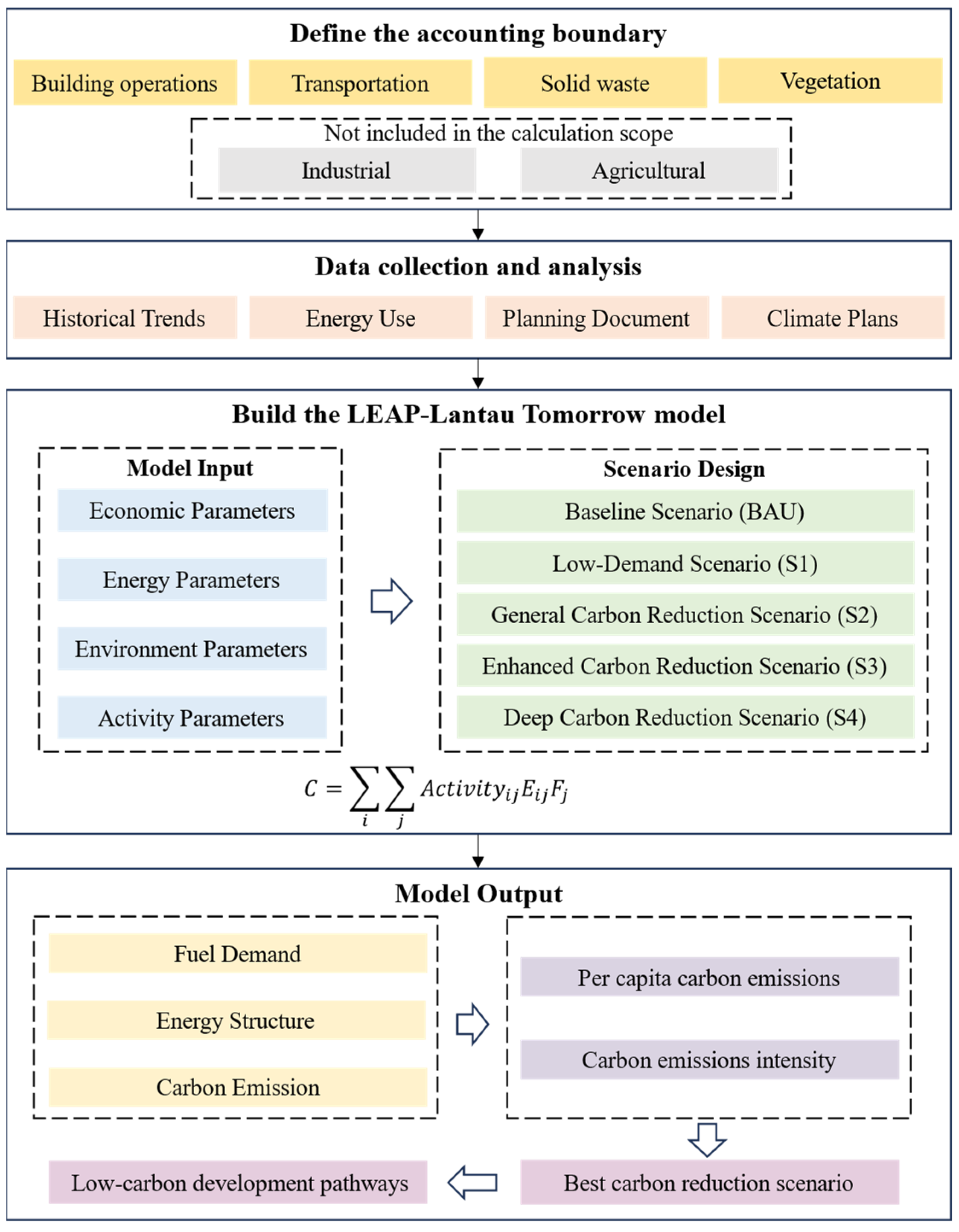
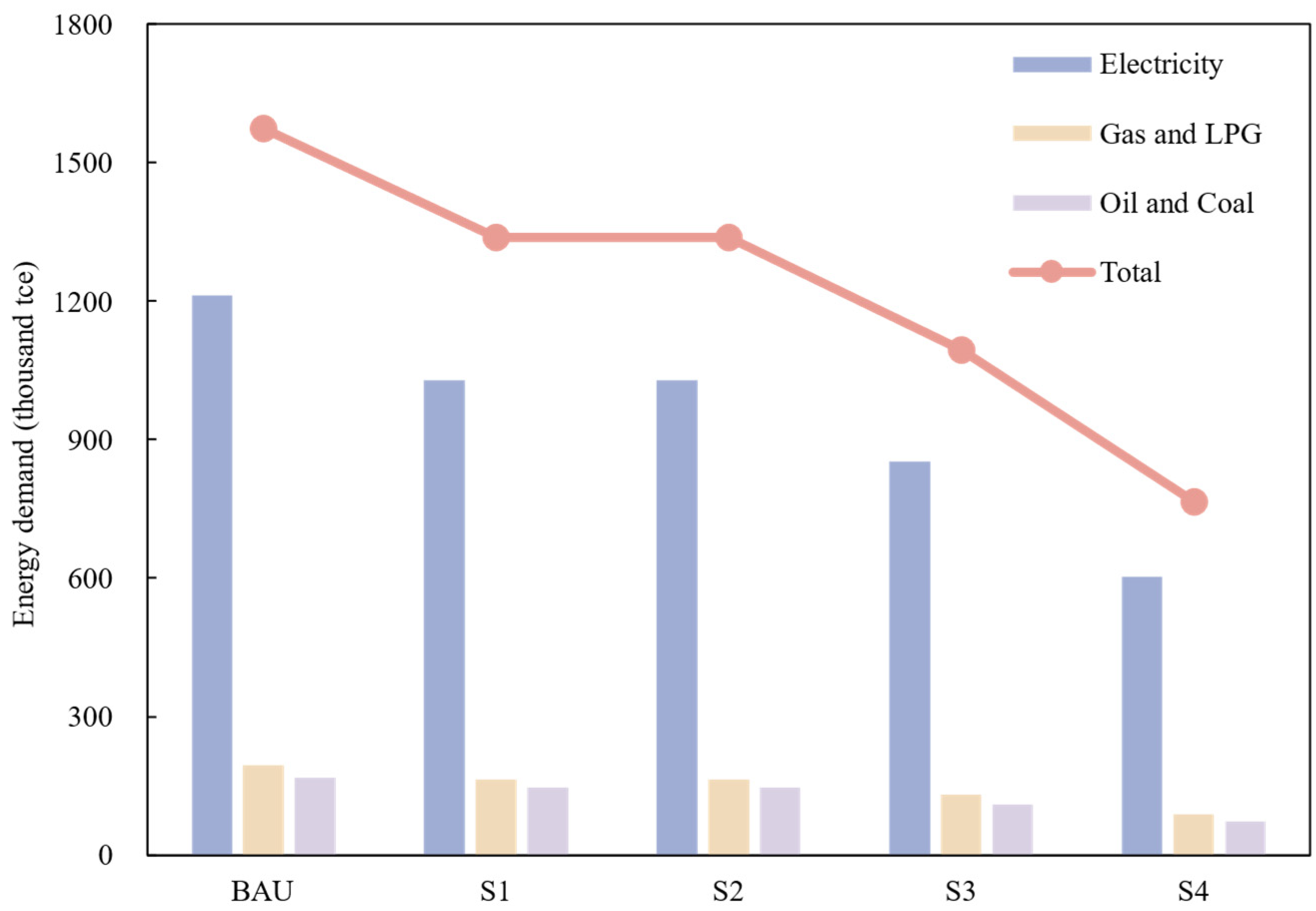
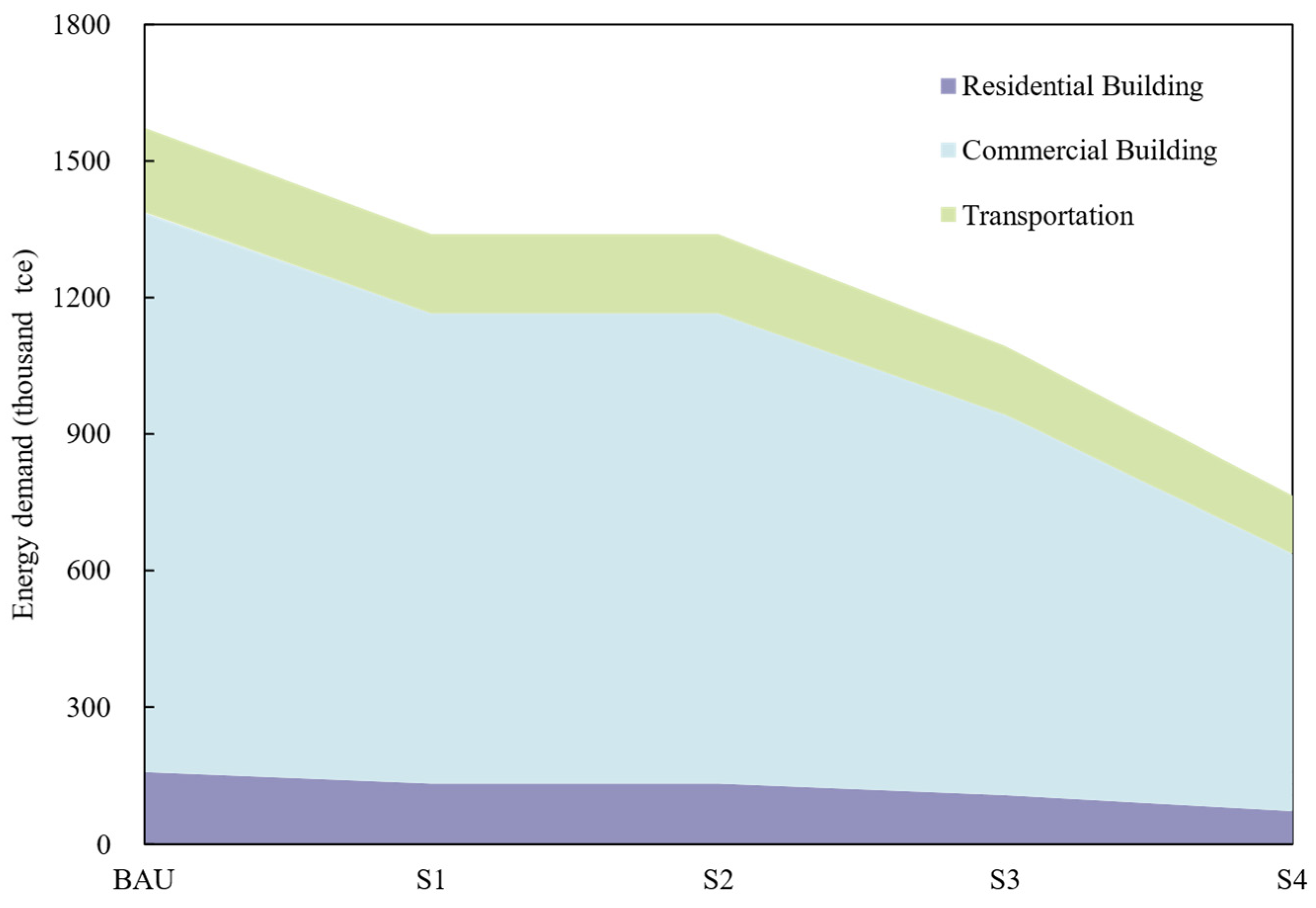
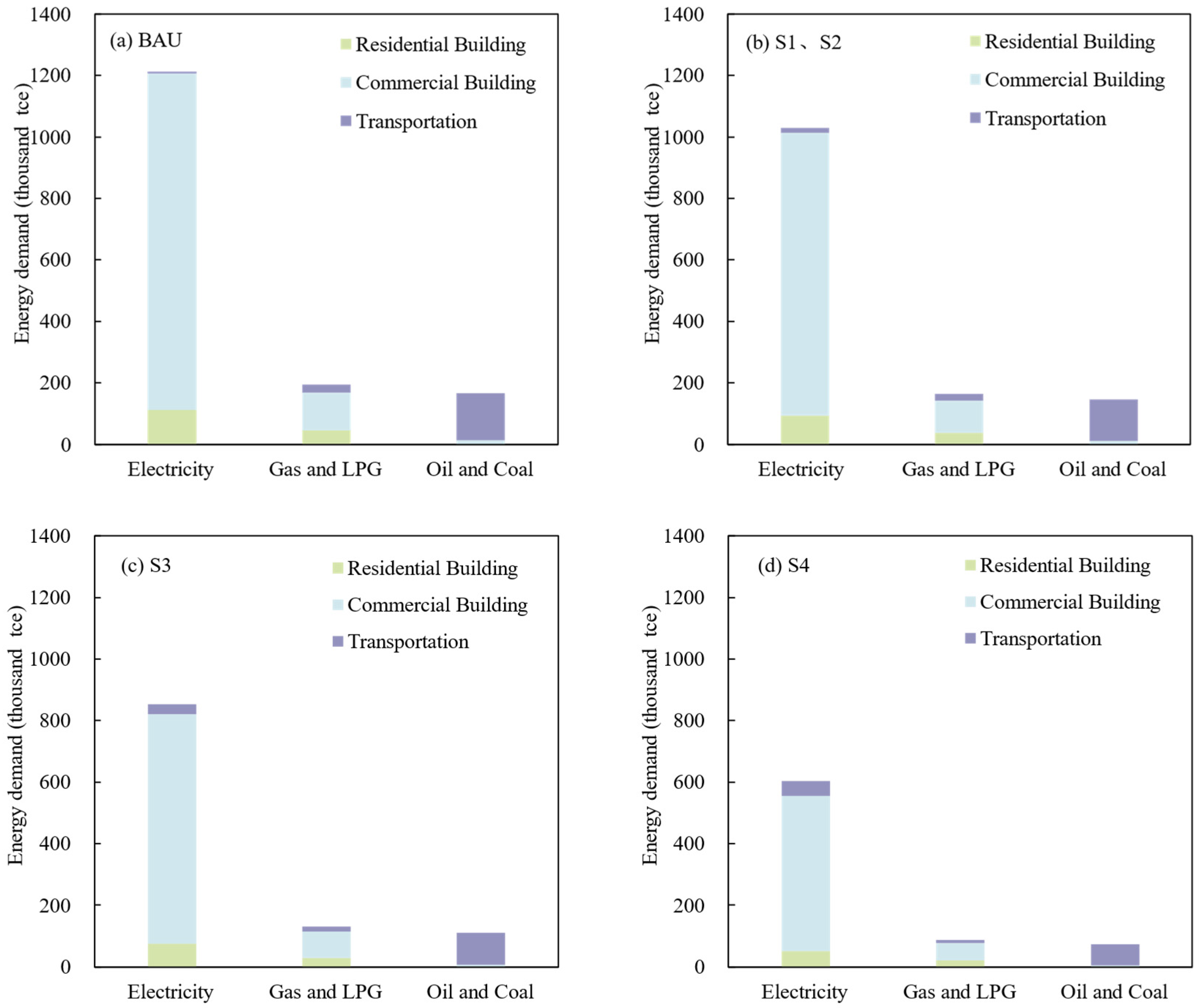
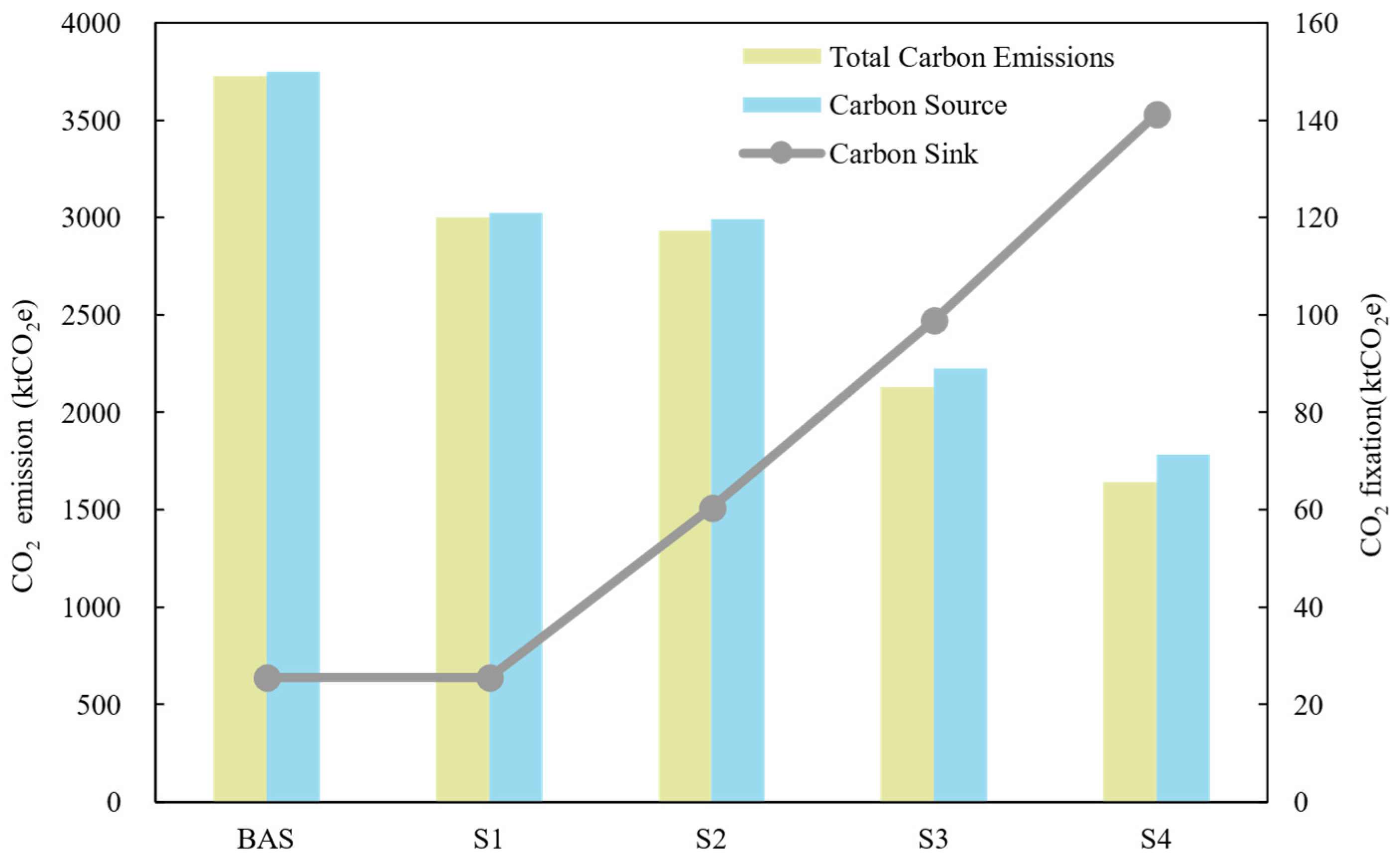
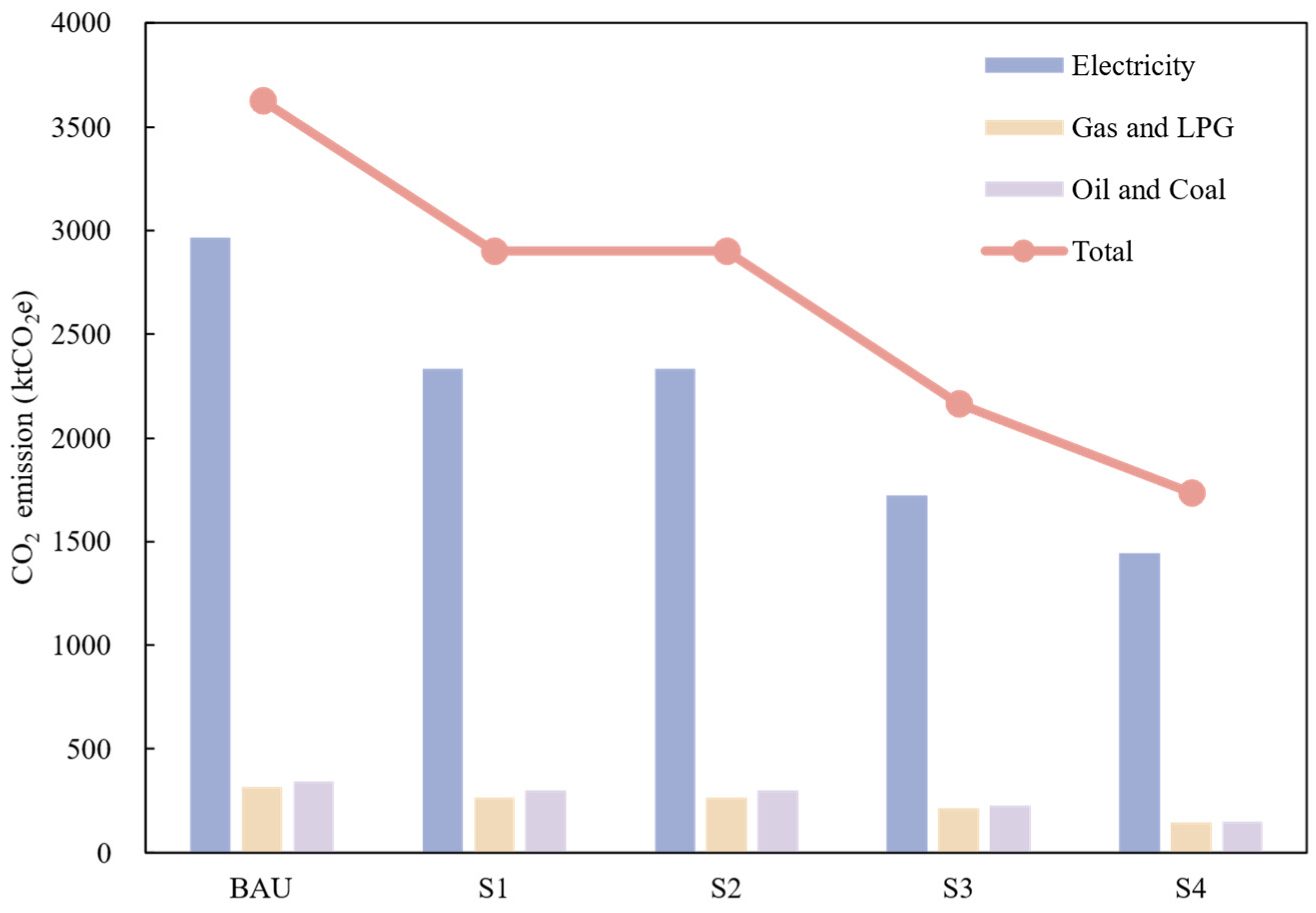
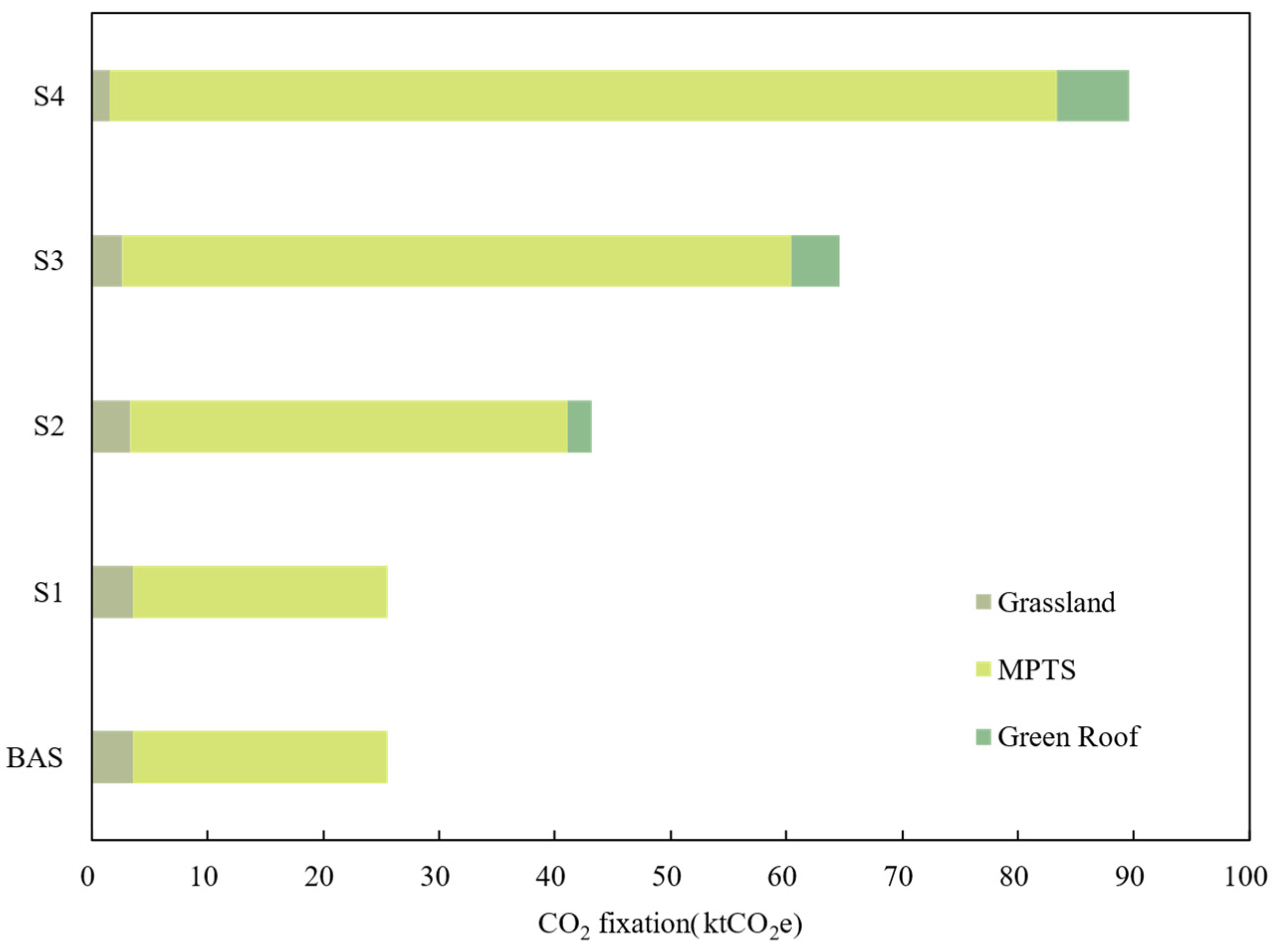

| Scenario | Accounting Sector | Scenario Description |
|---|---|---|
| BAS (Baseline Scenario) | Building | Maintain the current average energy consumption level for buildings in Hong Kong. |
| Transportation | The proportion of NEVs in the motor vehicle fleet is 8.6%. | |
| Solid Waste | per capita solid waste generation is fixed at 1.51 kg/person/day | |
| Vegetation | The greenery coverage rate is set at 20%. | |
| S1 (Low-Demand Scenario) | Building | Construct 20% ultra-low-energy buildings and 20% nearly zero-energy buildings. |
| Transportation | The proportion of NEVs in the motor vehicle fleet is 20%. | |
| Solid Waste | Remains consistent with BAS. | |
| Vegetation | ||
| S2 (Regular Carbon Reduction Scenario) | Building | Remains consistent with S1. |
| Transportation | ||
| Solid Waste | Per capita waste generation is reduced by 15%, with a recycling rate reaching 40%. | |
| Vegetation | Greenery coverage is increased to 25%, with MPTS occupying 55% of the green area, and 10% rooftop greening. | |
| S3 (Enhanced Carbon Reduction Scenario) | Building | Construct 40% ultra-low-energy buildings and 40% nearly zero-energy buildings. |
| Transportation | The proportion of NEVs in the motor vehicle fleet is 40%. | |
| Solid Waste | Per capita waste generation is reduced by 30%, with a recycling rate reaching 50%. | |
| Vegetation | Greenery coverage is increased to 30%, with MPTS occupying 70% of the green area, and 20% rooftop greening. | |
| S4 (Deepened Carbon Reduction Scenario) | Building | Construct 50% ultra-low-energy buildings and 50% nearly zero-energy buildings. |
| Transportation | The proportion of NEVs in the motor vehicle fleet is 60%. | |
| Solid Waste | Per capita waste generation is reduced by 45%, with a recycling rate reaching 55%. | |
| Vegetation | Greenery coverage is increased to 35%, with MPTS occupying 85% of the green area, and 30% rooftop greening. |
| Scenario | BAS | S1 | S2 | S3 | S4 |
|---|---|---|---|---|---|
| Per capita carbon emissions (ton) | 7.45 | 5.99 | 5.89 | 4.32 | 3.38 |
| Carbon emissions intensity (kgCO2e per HKD GDP) | 0.018 | 0.015 | 0.015 | 0.011 | 0.008 |
Disclaimer/Publisher’s Note: The statements, opinions and data contained in all publications are solely those of the individual author(s) and contributor(s) and not of MDPI and/or the editor(s). MDPI and/or the editor(s) disclaim responsibility for any injury to people or property resulting from any ideas, methods, instructions or products referred to in the content. |
© 2025 by the authors. Licensee MDPI, Basel, Switzerland. This article is an open access article distributed under the terms and conditions of the Creative Commons Attribution (CC BY) license (https://creativecommons.org/licenses/by/4.0/).
Share and Cite
Liu, X.; Zhang, M.; Chen, F.; Tong, Y.; Xu, K.; Wu, Z.; Lai, Y.; Zhou, Y.; Chen, X. Research on Carbon Reduction Pathways: A Case Study of Kau Yi Chau Artificial Islands. Land 2025, 14, 1622. https://doi.org/10.3390/land14081622
Liu X, Zhang M, Chen F, Tong Y, Xu K, Wu Z, Lai Y, Zhou Y, Chen X. Research on Carbon Reduction Pathways: A Case Study of Kau Yi Chau Artificial Islands. Land. 2025; 14(8):1622. https://doi.org/10.3390/land14081622
Chicago/Turabian StyleLiu, Xingyu, Ming Zhang, Foci Chen, Yunzhe Tong, Kexi Xu, Zezhou Wu, Yani Lai, Yuefu Zhou, and Xiangsheng Chen. 2025. "Research on Carbon Reduction Pathways: A Case Study of Kau Yi Chau Artificial Islands" Land 14, no. 8: 1622. https://doi.org/10.3390/land14081622
APA StyleLiu, X., Zhang, M., Chen, F., Tong, Y., Xu, K., Wu, Z., Lai, Y., Zhou, Y., & Chen, X. (2025). Research on Carbon Reduction Pathways: A Case Study of Kau Yi Chau Artificial Islands. Land, 14(8), 1622. https://doi.org/10.3390/land14081622







